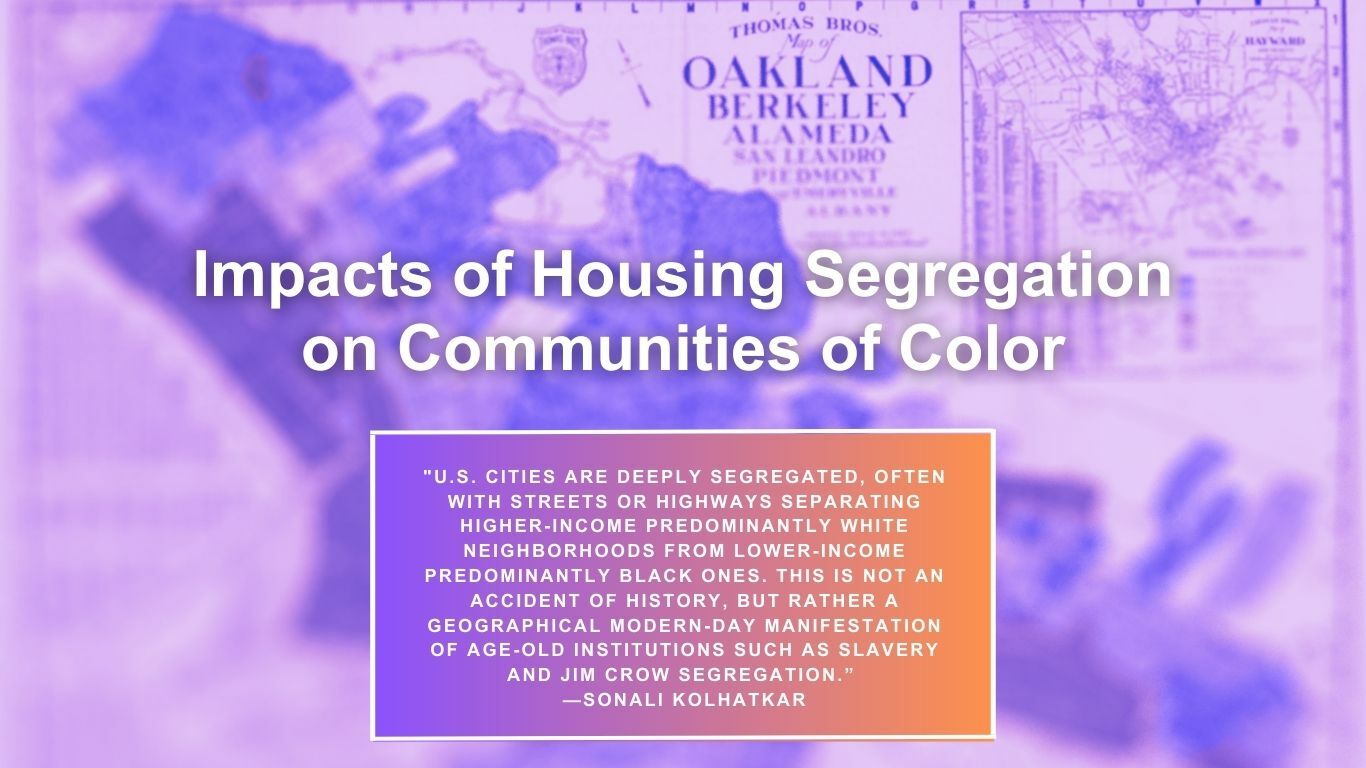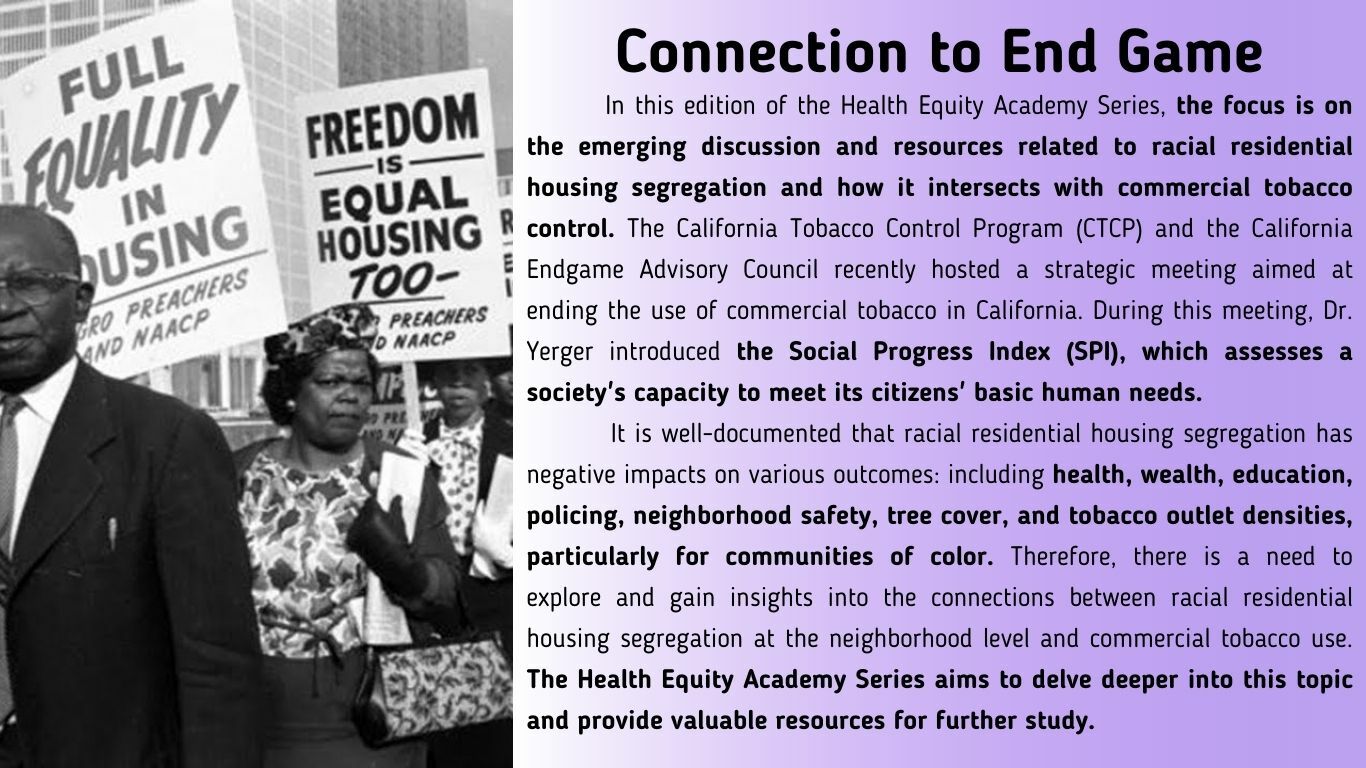Housing Segregation




Video: "The Roots of Structural Racism" Segregation Project Launch Event (Othering & Belonging Institute, UC Berkeley, 6/22/21)
Video: White Space, Black Hood: Sheryll Cashin presents her new book on opportunity hoarding and segregation (Othering & Belonging Institute, UC Berkeley, 11/05/21)
Local Histories of Segregation, from the Bay Area to Hartford, CT (Othering & Belonging Institute, UC Berkeley, 03/30/22)
Unnatural Causes: Is Inequality Making Us Sick? A seven-part documentary series exploring racial & socioeconomic inequalities in health, the groundbreaking and widely used California Newsreel series explores the impact of health disparities in the United States. As Dr. Lisa Cooper Founder and Director of the Johns Hopkins University Center for Health Equity and author of the new book, Why Are Health Disparities Everyone’s Problem? says "Health inequities actually increase costs to our entire society. They result in loss of productivity and competitiveness on an economic level; they result in community disharmony, stress, and civic unrest; [and they cause] a huge burden of human suffering."
On America’s Residential Caste System—and How to Abolish It. In her new book “White Space, Black Hood,” author Sheryll Cashin makes a compelling case for how segregated U.S. cities are organized as a residential caste system.

Racist Housing Practices From The 1930s Linked To Hotter Neighborhoods Today “...neighborhoods with higher temperatures were often the same ones subjected to discriminatory, race-based housing practices nearly a century ago… In a study of 108 urban areas nationwide, the formerly redlined neighborhoods of nearly every city studied were hotter than the non-redlined neighborhoods, some by nearly 13 degrees.” (NPR, 01/14/21)
Living Downstream: West Oakland's 'Diesel Death Zone' Meet the Oakland residents fighting environmental racism in one of the city’s most highly polluted neighborhoods. (The Oaklandside, 06/25/21)
Historian Keeanga-Yamahtta Taylor on the Racial Wealth Gap and the Crisis of American Capitalism"In the United States, it’s very stark that the past is not yet past. Problems that we think of as historical in fact continue to impact our lives on a daily basis." (KQED, 11/10/21)

The Roots of Structural Racism Project (UC-Berkeley’s Othering & Belonging Institute)
‘Where you live determines everything’: Why segregation is growing in the US (The Guardian, 06/28/21)
Othering & Belonging Institute updates investigation on Bay Area racial segregation (The Daily Californian, 10/19/21)
Where Did All the Black People in Oakland Go? Examining the intersection of housing policy and affordability in the East Bay Area, including how development interacts with Black displacement in Oakland. (Darrell Owens, The Discourse Lounge, 09/09/21)
The History of Gentrification in Berkeley: Part I Using Census data from 1940 to 2020 and historical research to tell the history of Black people in Berkeley, California and the origins of zoning, housing and displacement in the city. (Darrell Owens, The Discourse Lounge, 10/25/21)
Marin segregation worsened in last decade, new UC Berkeley census study finds (Marin Independent Journal, 10/12/21)
Racial residential segregation has gone down in Sacramento, study finds (The Sacramento Bee, 10/14/21)
Extreme Racial Residential Segregation In Oakland Despite Its Diversity (SF Gate, 10/13/21)
Here are the Bay Area’s most segregated, integrated communities (East Bay Times, 10/13/21)
This neighborhood in Marin is the most segregated in the Bay Area (San Francisco Chronicle, 10/07/21)
Sociodemographic inequities in tobacco retailer density: Do neighboring places matter? The researchers concluded that policymakers should prioritize interconnected geographic areas experiencing high racialized and socioeconomic segregation when designing and implementing policies to reduce retail tobacco product availability. (Kong, Delamater, Gottfredson, Ribisl, Baggett & Golden; 2021)
Heavy trucks are barred from I-580. Is it time to rethink the 70-year-old restriction? Since 1951, an 8.7-mile stretch of road from Grand Avenue to the San Leandro border has been off-limits to truckers. First applied to city thoroughfares and later Interstate 580, the ban has funneled truck traffic through Interstate 880, along East Oakland’s industrial and residential flatlands. (Dave DeBolt, The Oaklandside, 12/14/21)
